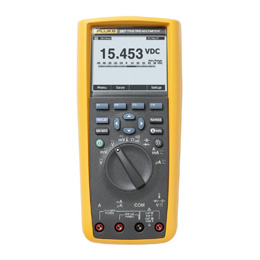Multimeters are used for varied measurement functions. With the many logging multimeters available for sale in the market, choosing the right electronic gadget of this kind is important. Fluke has two logging multimeter models designed for the same use, but featuring different performance capabilities. So, which of the two Fluke multimeters is superior to the other?


The Fluke 287 Multimeter
The Fluke 287 multimeter has zoom capabilities and comes with a TrendCapture feature that documents the gadget’s design performance very fast and displays occurrences in graphics. With this electronic gadget, you can easily log and zoom in on different issues. If you need to detect a trend or access many logging sessions, you do not have to make any PC downloads because the multimeter comes with distinct graphing and logging capabilities. Unlike other multimeters by Fluke or any other brand, this device is designed for convenience and accuracy.
It caters for applications that require high accuracy to attain optimal performance and thus results.The Fluke 287 multimeter device comes packed with 6 AA batteries, a user manual, a probe holder, TL71 silicone test leads, and a couple of AC72 alligator clips. The user manual is available in 16 languages to ensure that the device can be used universally by people from different backgrounds.
The True-RMS electronic multimeter features an optional ir3000 FC connector that uses infrared technology and is normally sold independently. Through this connector, you can connect your multimeter to test tools activated with all Fluke Fluke Connect and it is highly compatible with the mobile application dubbed Fluke Connect. The ShareLive video call feature works with the ir3000 FC WiFi connector and the Fluke Connect mobile application; this allows you to share information with colleagues or relevant persons.
TrendCapture data can be viewed and analyzed using the zoom on trend feature that works 14 times faster. When the selectable AC filter works under the smoothing mode, it displays a constant reading when the input signal is either noisy or change often. For a new event’s initial readings, you have to specify a % change needed, thanks to the auto hold thresholds. It also features a large 50,000 count, ¼ VGA display with light located at the back.
The logging function featuring more memory allow for unattended signal monitoring over a certain period of time. Irrespective of your measurement needs, the True-RMS multimeter is designed to perform many measurements and display them at the same time in many languages. The accuracy of DC is 0.025%, bandwidth is 100 kHz AC, 100mF capacitance, and you can use it to measure voltage of up to 10 amps.
The logging multimeter comes with a real clock to time-stamp readings that are saved automatically. When dealing with loads that are non-linear or complex signals, opt for Fluke’s 287 True-RMS to measure current and voltage precisely. It also comes with a limited lifetime warranty.
The Fluke 289 Multimeter
The Fluke 289 logging multimeter is a stand-alone device that comes with all the above features of the 287 model. However, it runs approximately 100 hours and 200 hours in the logging mode. It is an AC device that measures current and voltage accurately. The two models are used to measure resistance, current, voltage, capacitance, frequency, temperature, pulse width, conductance and duty cycle.
Conclusion
In my opinion, the two multimeters have similar functions and features. They are both small in size and light weight, hence portable. In fact, they are small enough to fit into any pocket. Therefore, it is better to compare the two logging electronic multimeters by price. Compare their prices to determine which of the two is pocket-friendly. The multimeter with a lower price should be viable in case you are working on a tight budget. In terms of functionality, available features and performance, the two gadgets are the same. So, whichever you choose should work just fine.
Click here to purchase Fluke 287 on Amazon!
Click here to purchase Fluke 289 on Amazon!